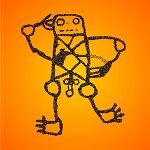 My paper describes the images on a boulder that has one of the most complex biomorphic petroglyphs in the Majes Valley and in Arequipa rock art. It may well be death-related, as will be demonstrated. Another death-related petroglyph on an adjoining panel definitely links the boulder – and the whole site – with Apu Coropuna, the most Sacred Mountain of the whole of southern Peru.
My paper describes the images on a boulder that has one of the most complex biomorphic petroglyphs in the Majes Valley and in Arequipa rock art. It may well be death-related, as will be demonstrated. Another death-related petroglyph on an adjoining panel definitely links the boulder – and the whole site – with Apu Coropuna, the most Sacred Mountain of the whole of southern Peru.
By Maarten van Hoek
*
*
The Case of Boulder AP3-060, Alto de Pitis
Majes Valley, Southern Peru
Maarten van Hoek
Click on each illustration to see an enlargement
*
Introduction
Alto de Pitis probably is one of the most important petroglyph sites in the Desert Andes of South America. Together with its neighbour, Toro Muerto, it forms the biggest concentration of petroglyphs in the Andes. Although both sites have their share of idiosyncratic images, especially Alto de Pitis has more very specific rock art images (relatively speaking). Many of those exclusive images are moreover often found on enormous boulders of rather soft volcanic rock. The petroglyphs on two of those huge boulders have already been discussed by me. It concerns Boulder AP1-001 (Van Hoek 2022a) and Boulder AP3-172 (Van Hoek 2022b). This paper describes some intriguing petroglyphs on a third large boulder, Boulder AP3-060.
*
Location
Alto de Pitis (a long, narrow boulder field stretching about 4 km from south to north) is found on the east bank of the Majes Valley (Figure 1) at an average height of about 500 m asl. Based on our surveys, I have arbitrarily divided the rock art site of Alto de Pitis into four Sectors, called (from south to north) Sector AP1 to AP4. However, those four Sectors in fact form one large, continuous boulder field (intersected – and thus partially destroyed – by the modern road from the “white” city of Arequipa to the Majes Valley).
Figure 1: Location of Alto de Pitis in the Central Majes Valley, southern Peru. Map © by Maarten van Hoek, based on the map © by OpenStreetMap – Contributors.
Boulder AP3-060 is located in the northern part of Secor AP3, about 450 m east of the cliff forming the east edge of the valley and 4890 m SSE of Corire town centre. The coordinates are: 16°15’37.18″ S and 72°26’41.58″ W in Google Earth and the altitude is about 513 m asl, while the valley floor (just west of the cliff) is found at 400 m asl (Figure 2). Consequently Boulder AP3-060 is found some 113 m above the valley floor and is thus invisible from there. Very near Boulder AP3-060 are three decorated boulders (AP3-061 and 062, both at 12 m NW) and (at 20 m SE) Boulder AP3-063 (Figure 3).
Figure 2. Part of Sector AP3 at Alto de Pitis, showing the location of Boulder AP3-060. Map © by Maarten van Hoek, based on Google Earth.
Figure 3. View of Boulder AP3-060 from the NW. Photograph © by Maarten van Hoek.
The views from Boulder AP3-060 are impressive. Especially the panorama to the north is important, because the snow-clad summit of Apu Coropuna, the most important Sacred Mountain of the whole region, is clearly visible about 83 km to the NNW (Figure 4). The view to the west (Figure 5) and NW include the linear concentration of petroglyphs at the Cliff Edge, as well as distant glimpses of the enormous boulder field of Toro Muerto. To the south and east the prospects only include the barren, undulating plain of Alto de Pitis and the bleak mountains beyond (see for instance Figure 3).
Figure 4. View of Boulder AP3-060 from the south. Photograph © by Maarten van Hoek.
Figure 5. View of Boulder AP3-060 from the east. Photograph © by Maarten van Hoek.
*
Boulder AP3-060
Boulder AP3-060 has at least four decorated panels, which will be discussed in more detail below. The boulder is estimated by me (I did not take measurements) to measure approximately 220 cm in height and about 400 cm in length. My guesstimates are based on two scales that are visible in a photo published by academic archaeologist Paul Álvarez Zeballos (2009). One is a small 5-cm scale (?) stuck onto the centre of Panel AP3-060B, and the second concerns a measuring rod – still visible in Figure 4 – which was probably left behind by Álvarez Zeballos.
Álvarez Zeballos just possibly is the first to have seen (recorded?) this boulder. He even claimed to have been the very first person to have surveyed Alto de Pitis, although in 2013 I found out that it was actually Hiram Bingham who was the first to explore the site in 1911, while years later (at least in 1957) Eloy Linares Málaga (and other researchers) surveyed the site (the unjust “Álvarez” claims are fully discussed in Van Hoek 2013: 32 – 39). Unfortunately Álvarez Zeballos does not at all describe Boulder AP3-060; he only published one photo (of only Panel AP3-060B) in his 2009-survey. Therefore he seems to have missed some very important images. The surveys by my wife Elles and me revealed many – previously unrecorded – petroglyphs at Alto de Pitis, also on Boulder AP3-060 (Van Hoek 2013: Figs 127 and 128). This study attempts at describing the most important images on this stone.
*
Panel AP3-060A
This east facing and rather steeply sloping panel is rather flat yet rough and – unfortunately – heavily wind-eroded at its top end. Several petroglyphs have thus partially been destroyed and blurred, like the two south-facing felines (depicted in “twisted” perspective and thus most likely having east facing faces) (Figure 6B). Also partially destroyed is the very complex image of a large, frontally depicted bird with wide-spread wings (Figure 6A). Lower down the panel are some rather small petroglyphs (most of them deeply patinated) of at least five quadrupeds (outlined and match-stick examples), two small anthropomorphic figures and several indeterminable petroglyphs (some almost invisible; one just possibly depicting a feline, only its tail being somewhat clearer).
Figure 6. Petroglyphs near the top of Panel AP3-060A. Photographs © by Maarten van Hoek.
However, the most important petroglyph on this panel concerns a large petroglyph of a “Carcancha”; a “Skeleton-Anthropomorph”, an icon that is most characteristic for the Majes Rock Art Style (MRAS) (for more detailed information regarding the icon of the “Carcancha”; in South America see Van Hoek 2013; and 2019 for a global review). Although it has no clear ribs, it has a large circle at each of the ‘joints’ of the “elbows” and “knees” (Figure 7). Circles or knobs at the joints are a telling clue indicating that we are dealing with a “Skeleton-Anthropomorph”. Also the large, outlined hands and feet (with digits) are characteristic for a “Carcancha”. Especially the position of the arms and hands is telling. Its right arm shows the so-called “saluting” pose, touching the head (thus possibly emphasising the importance of the head in Andean worldview), while the other is touching the abdomen area (pointing to the genitals?).
Figure 7. The “Carcancha” on Panel AP3-060A. The two felines and the bird can be seen at the top of the boulder (see Figure 6). Photograph and drawing (possibly inaccurate) © by Maarten van Hoek.
Indeed, most significant is the explicit presence of large male genitals in this figure. In general the depiction of genitals are very rare in Desert Andes rock art (Van Hoek 2012)! The male sexual organ is most prominently dangling between the knee-joints. All these features combined confirm that also this “Carcancha” symbolises the significant Andean concept of the Life-Death duality. The skeleton-properties symbolise Death, while the dynamic pose and the genitals represent Life.
*
Panel AP3-060B
On the south facing, almost vertical panel of this huge boulder is what – at first sight – looks like a chaos of petroglyphs (see Figure 4). With some difficulty some six birds can be distinguished (all of the Three-Digit-Claw Type; see Van Hoek 2018 for a detailed explanation regarding the types of birds in MRAS). One of the large profile birds seems to be associated with a small, striped “snake” and a small, enigmatic biomorph that looks like an animal playing a wind instrument (Figure 8B), but my interpretation may well be an instance of subjective, “wishful thinking” and is probably incorrect.
Figure 8. Details of Panel AP3-060B. Photographs © by Maarten van Hoek.
There are five outlined snake-like images, one decorated with lines, the others with often randomly distributed dots. The smallest, striped snake is about 25 cm in length (see Figure 8B), while the largest (meandering at the bottom of the panel) may even measure about 300 cm (hard to measure with all the curves). It is one of the longest snake petroglyphs in MRAS. The longest example – said to measure no less than 15 meters – has been recorded at the remote rock art site of Cíceras, 24 km NNE of Alto de Pitis (Van Hoek 2021a).
On this panel there are also at least three outlined and decorated quadrupeds and five, much smaller match-stick examples. There are several small simple petroglyphs, like serpentine grooves, one concentric ring-central dot image and a few indeterminable petroglyphs and/or anthropic markings.
Surprisingly there is only one certain anthropomorphic figure. Near its west edge is a figure (35 cm tall) in “saluting” position (Figure 8A; red arrow in Figure 9). It has large drooping feet. Importantly, one hand is placed on the abdomen (or the genital area). The thorax has no ribs, but incorporates a small square instead. The small head has a dot in its centre. A circle between the feet might be indicative of (male or female?) sex. Despite the lack of ribs and joints, I classify also this petroglyph as a (possible?) “Carcancha”.
Figure 9. Detail of Panel AP3-060B. Notice Apu Coropuna in the background. Photograph (with guesstimated scale) and drawing (possibly inaccurate) of the purported complex “Mummy Bundle” (indicated between two white arrows) © by Maarten van Hoek.
Most fascinating and dominating this panel however is a large petroglyph depicting a most complex and “weird-looking” biomorphic pattern characterised by a patterned “body” and numerous curved appendages emerging from the “body” that in some cases are segmented (Figure 9). It seems to have some sort of “head”. It measures about 92 cm in height. It is one of the most complex petroglyphs that I know of in MRAS. It may either depict an imaginary zoomorph or even a Mummy Bundle. The pattern of the body more or less resembles the pattern on the Mummy Bundle on Panel TM-Fa-001B at Toro Muerto. The appendages could possibly represent the ropes with which the bundle would be wrapped with.
*
Panel AP3-060C
The north face of Boulder AP3-060 has two panels (Figure 10). Panel C is almost vertical and rather smooth. It has a few deeply patinated petroglyphs that for that reason are hard to see in certain lights. There is at least one large, fully hacked quadruped executed in a diagonal position. Above the badly visible head is a circle (a head with possible dots as facial features?) with two parallel lines (a neck?). To the right is a long, vertically arranged snake decorated with a line of dots. To the right of the snake’s head seems to be the large head of what is possibly a bird. The lines of the neck of this purported bird continue a short distance onto Panel F. There are some more indeterminable, small petroglyphs on this panel.
Figure 10. Panels AP3-060C and 060D. Photograph © by Maarten van Hoek.
*
Panel AP3-060D
To the left of Panel C projects Panel D. On its fragmented surface are at least two petroglyphs (both small and possibly abraded), one depicting a diagonally executed quadruped with a long tail curved over its back (a feline?), Its two ears are faintly visible. Panel AP3-050F and (especially) west facing Panel E (see Figure 3) are heavily weathered, exfoliated and wind-eroded, but may still have some much weathered petroglyphs.
*
Boulders AP3-061 and 062
A short distance to the NNW of Boulder AP3-060 are two more boulders with petroglyphs (Figure 11; see also Figure 3). Boulder AP3-061 has one simple, match-stick petroglyph of a quadruped (most likely a camelid), while – in strong contrast – Boulder AP3-062 has a most complex and enigmatic petroglyph that may well depict a strangely deformed quadruped (judging by the two purported segmented legs). Its interior shows a serpentine line that seems to end in a head. From the right side of the “body” runs a straight line that ends in a circle (a leash?; compare this feature with similar lines from camelid petroglyphs at Quilcapampa in the Sihuas Valley; Van Hoek 2021b: 44; Fig. 20). Below this line is a group of randomly arranged dots.
Figure 11. Boulders AP3-061 and 062. Photographs © by Maarten van Hoek.
*
Conclusions
Boulder AP3-060 is positioned between two concentrations of rock art at Alto de Pitis. To the west is the Cliff Edge Group, while to the east is the Hill Top Group (see Figure 2). All three spots are characterised by the occurrence of one or more iconic “Carcancha” petroglyphs and from all three spots there are full views of Apu Coropuna (see Van Hoek 2013 for full details). Importantly, at Alto de Pitis there is a significant “overkill” of images depicting those “Skeleton-Anthropomorphs”, which I explained by the fact that from Alto de Pitis the Sacred Mountain of the region, Apu Coropuna, is clearly visible. I now argue again that the petroglyphs of “Carcanchas”, “Trophy” Heads and Mummy Bundles serve to ritually convey the souls of the deceased onto the top of Apu Coropuna, where the deities and the spirits of the area and the ancestors of the deceased reside.
For that reason it is reasonable to argue that the very complex biomorphic pattern on Panel AP3-060B (see Figure 9) may well represent a Mummy Bundle with ropes still lying outside, ready to receive and wrap the body of a deceased person, which – in this case – may well be the small anthropomorphic figure to its left (west) (see Figure 8A). When looking at this possible association, one has clear views of the snow-clad summits of Apu Coropuna (see Figs 4 and 9), the purported destination of the Mummy Bundle. The “Carcancha” petroglyph on Panel AP3-060A and the purported Mummy Bundle on Panel AP3-060B are in my opinion definitely related to the Sacred Mountain that is Apu Coropuna. Moreover, in strong contrast with the other valleys of the MRAS where “Carcanchas” are less dominantly represented, it is remarkable that Life-Death related images are over-represented in absolute terms in the Majes Valley, which has therefore been labelled the “Death Valley of the Andes” by me. Of course, lacking informed knowledge this all is just a theory. Therefore I am prepared to consider any alternative reading of the symbolism of “Carcanchas”, “Trophy” Heads and Mummy Bundles.
I am grateful to my wife Elles for her assistance during several surveys at Alto de Pitis and for her ongoing support at home.
*
References
Álvarez Zeballos, P. J. 2009. Petroglifos de Cantas, Pitis, La Mezana y La Laja; Valle de Majes. No longer accessible at Arqueología de Perú. PDF available via me.
Van Hoek, M. 2012. Rumimantam Llaqllasaq Wirpuykita: The ‘Cycle of Life’ in the Rock Art of the Desert Andes. Oisterwijk, The Netherlands. Book only available as PDF at ResearchGate.
Van Hoek, M. 2013. The Carcancha and the Apu. Rock Art in the Death Valley of the Andes. Oisterwijk, Holland. Book only available as PDF at ResearchGate.
Van Hoek, M. 2018a. Formative Period Rock Art in Arequipa, Peru. An up-dated analysis of the rock art from Caravelí to Vítor. Oisterwijk, Holland. Book only available as PDF at ResearchGate.
Van Hoek, M. 2019. The Book of Bones – ‘Carcanchas’ in Global Rock Art. Oisterwijk, Holland. Book only available as PDF at ResearchGate.
Van Hoek, M. 2021a. The Cíceras “Carcancha-Bird” Petroglyphs, Majes, Peru. In: TRACCE – Online Rock Art Bulletin, Italy.
Van Hoek, M. 2021b. Accessing the Inaccessible. Rock Art of Quilcapampa, southern Peru. Oisterwijk, the Netherlands. Book only available as PDF at ResearchGate.
Van Hoek, M. 2022a. The Case of Boulder AP1-001, Alto de Pitis, Majes Valley, Southern Peru. In TRACCE – Online Rock Art Bulletin, Italy. PDF available at ResearchGate.
Van Hoek, M. 2022 b. The Case of Boulder AP3-172, Alto de Pitis, Majes Valley, Southern Peru. In: TRACCE – Online Rock Art Bulletin, Italy. PDF available at ResearchGate.
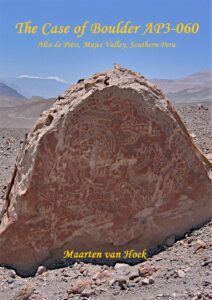
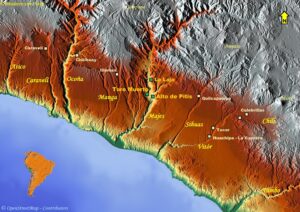
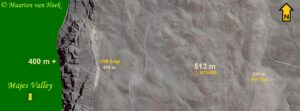
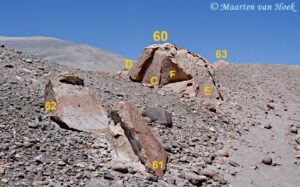
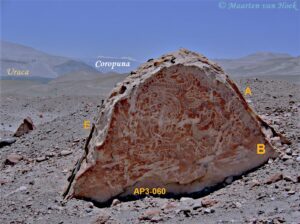
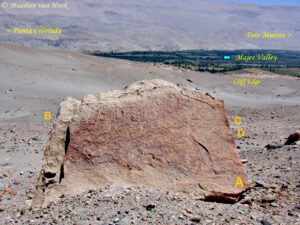

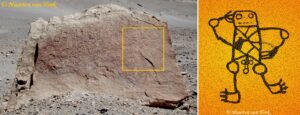
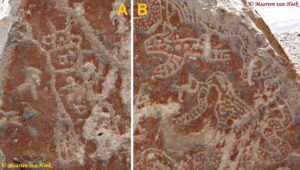
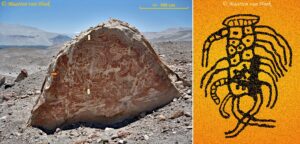
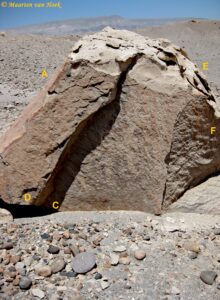
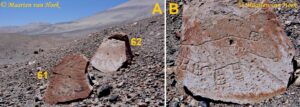
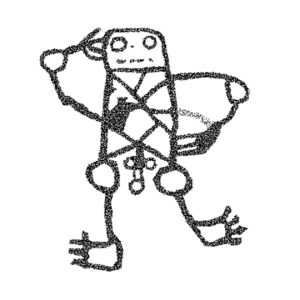














Leave a Reply